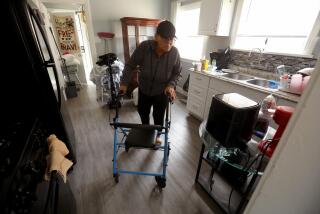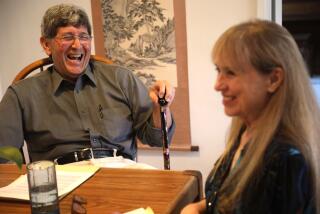Nurse manages her pain and young cancer patients one song at a time
Barbara Britt has a song in her head, a campfire tune that she learned years ago.
Iâm a little piece of tin.
Its silliness, she knew, would keep her upbeat for the appointment she had with James Lee, the 12-year-old with a tumor in his brain stem.
Nobody knows where I have been.
James was one of nearly a dozen patients scheduled for todayâs clinic, and Britt, a nurse care manager at Childrenâs Hospital Los Angeles, has found that songs keep her from becoming overwhelmed by the lives of her patients and their families. Itâs a strategy sheâs learned from 40 years in the company of children with brain and blood cancers.
Five months ago, James, a shy sixth-grader with a book always in hand, had come to the hospital complaining of headaches, and today, after six weeks of radiation, he was about to begin chemotherapy.
They sat in a narrow exam room with Jamesâ stepmother, Suk Young Kim, who understands a little English, and as they waited for the Korean interpreter, Britt began to explain the dosages and the side effects of three medications. Kim spoke to her son.
âShe wants to know why youâre telling me this,â James said, relaying the question.
âBecause you get to be a help to her,â Britt said. âYouâre old enough that you need to know whatâs going on with you. Right?â
James put down the novel he was reading, âSo Totally Emily Ebers,â and Britt explained the side effects of the drugs.
âBut what else do they do?â he asked.
âWell, all together these three medicines help your tumor no longer grow.â
âIsnât it also to make it disappear?â
Britt had to be honest. âWe arenât sure if we can make it go away.â
âThat would be really good if you could.â
Yes, Britt thought, but the tumor is incurable and he needed to know that. For many children, treating a brain tumor means arresting its growth and teaching them how to live with it for the rest of their lives.
âYou know how well you feel now?â she asked.
âI feel pretty good,â James said, sounding tentative.
âSo it wouldnât matter if that tumor stayed the same size forever,â she said. âThat would be good, wouldnât it? Because you feel good now.â
A knock on the door interrupted them. The interpreter stepped in, and James went back to his book.
Britt repeated the instructions for the boyâs medications â three to be taken at night, one in the morning and one an hour before all the others â to Kim, who was eventually overwhelmed.
âWhy is she crying?â James asked, looking over the top of his pages.
âBecause this is a lot to take in,â Britt said, âand this is what adults do when they love someone.â
::
The clinic on Wednesdays is Brittâs chance to escape the onslaught of daily emails and spend time with her patients.
Dropping into one exam room after the next, she got a hug from Maddison Franks, a high school senior in for a new round of chemotherapy. She saw how 12-year-old Jordan Johnson, sporting a black fedora, was tolerating his radiation, and she caught up with Tom Plunkett and 5-year-old Luna, whose recent scans showed no recurrence of her tumor.
As a member of the hospitalâs neural oncology team â comprised of doctors, nurses, social workers, psychologists and researchers â Britt, 62, coordinates various facets of care, overseeing the medical, social and psychological effects of both the illness and treatment.
Jonathan Finlay, director of the neural oncology program, has worked with Britt for nine years. âHer skill at reading families â reading their emotions, where they need support and knowing when it is time just to listen â those are facets of her character that make her unique in this effort,â he said.
In meetings between patients and doctors, Britt often asks questions, simplifies medical terms and interprets recommendations. She understands how frightened most parents are when they first encounter diseases with names as intimidating as medulablastoma, astrocytoma, oligodendrogliomas.
âThey are immobilized as if the floor had been ripped out from under them,â she said. âMy job is to help them realize that the floor is still there.â
The challenge is to strike a balance between the discomfort of treatment and the preservation of daily routines. For Britt, the names of the tumors, even the symptoms, matter less than the fact that the disease changes a childâs life forever. In her mind, what best defines a brain tumor is whether it leaves room for hope or not.
âA doctor treats disease, and a nurse treats patients. Barbara treats families,â said Mark Maxwell-Smith, a 65-year-old television producer who for almost 15 years has joined Britt at a summer camp for children with cancer.
She keeps files on 180 patients; some are infants, some are in their 20s, most are in between. Most are also in remission. Itâs the new diagnoses and recurrences that keep her on the phone and answering emails until late at night.
âWhy does my daughter have these stretch marks?â Itâs a side effect of the steroid sheâs taking.
âIs this headache serious?â Probably not. See what Tylenol does.
âWhat are the numbers?â The hemoglobin and platelets are up, but the white count is the same. No transfusion is necessary.
Brittâs days are often drawn out by consultations and paperwork: an absence slip for a school, a family leave request, a death certificate for the mortuary, a petition to an insurance company, an authorization for the pharmacy.
Her desk is in a windowless room shared with up to three other nurses. Above her on the wall are certificates, diplomas and photos of children surrounded by pine trees, snapshots from the camp in Idyllwild where they go to forget they have cancer.
Files compete for space with cans of diet Coke and vases of roses from home, a 100-year-old farmhouse in Camarillo that she rents with five others â her sister, a niece, a nephew, his girlfriend and their baby. Describing herself as a professional aunt, she has never been married and has no children. Her garden and her Scottish terrier, Max, are her distractions.
When she started â a 1971 graduate of Cal State L.A. whose first job was at L.A. County/USC Medical Center â nearly all her patients died, and as upsetting as it was, she learned that in order to do her job, she had to keep an emotional distance. Today the outcomes for children with brain tumors are better, but thatâs little solace.
âThe bad can be so bad that they count for more,â she said.
A Presbyterian, Britt believes in a God who is good but not omnipotent. Yet she knows that faith offers little comfort for parents who leave the hospital without their child. Often on her hourlong commute home, the songs that she sings to herself are requiems.
::
The clinicâs last appointment was at 3:30, and on a day of mostly good news â tumors shrunk, scans clean, chemo started â Britt braced herself for seeing Jesus Garcia, the funny, proud, polite and confident 19-year-old she first met three years ago. The song that came to her was the hymn, âBe Still, My Soul.â
Thy hope, thy confidence let nothing shake âŚ.
Garcia sat alone in an exam room. He had taken the bus to the hospital, an hour-and-a-half ride from his home near Leimert Park.
All now mysterious shall be bright at last.
Last week Garcia complained of headaches and nausea, and Britt and his doctor, Girish Dhall, feared that his tumor was back. A new scan confirmed it.
âAfter so many surgeries, more surgery would not be helpful,â Dhall said. âThere are other medications we can try.â
Britt knew that Dhall wanted to give Garcia a little hope, but she also had to make sure Garcia understood the serious nature of his disease at this stage. The odds of surviving were extremely long, and short of a miracle, there was little they could do for him.
âIt sucks, Jesus,â she said, pulling closer, placing a hand on his knee. âYour tumor looks bigger than it ever did, and it doesnât look like a very friendly mass.â
âYouâre scaring me,â he said.
Dhall listened as Britt continued. âYes, I know,â she said, âand there will be come a time when you will not be able to care for yourself. People die of these tumors before they grow old.â
âWho wants to be old?â
âThis is scary stuff,â she said. âDamn it, Jesus, youâre one of my favorite kids.â
He didnât say anything.
âWhat can we do for you?â
He asked if she would call his mother who had moved to Idaho with her boyfriend, leaving Garcia and his two older sisters on their own.
âShe will cry,â Britt said.
âI could cry too, but Iâm holding it in.â
âWill she come back to help you?â
âHopefully.â
Experience has taught Britt how to help her families and patients set the priorities in their lives and to keep their expectations for the future realistic.
She said goodbye, leaving Garcia and Dhall alone. She was desperate for a Coke, an Excedrin and a place to cry, but just past the nurseâs station, she saw Parker Brockway and her mother, Kathy Kelley.
âI have to see Parker,â Britt said. âPerfectly perfect Parker.â
The song in her head was âBuddies and Pals.â
You and me are gonna be partnersâŚ
Nearly six years ago Parker was diagnosed with a tumor in her cerebellum. Since then, she has had 13 surgeries and is in her third round of chemotherapy. She had come into the hospital today for a blood test and for a treatment to help ward off pneumonia.
Standing beside the 7-year-old with a pageboy haircut and dimples, Britt lifted up her pant leg so they could compare their shoes. Parkerâs pink sandals, it was decided, were far cuter than Brittâs black and gray flats.
Britt reached for Parkerâs hand, and together they walked down the hall.
More to Read
Sign up for Essential California
The most important California stories and recommendations in your inbox every morning.
You may occasionally receive promotional content from the Los Angeles Times.











